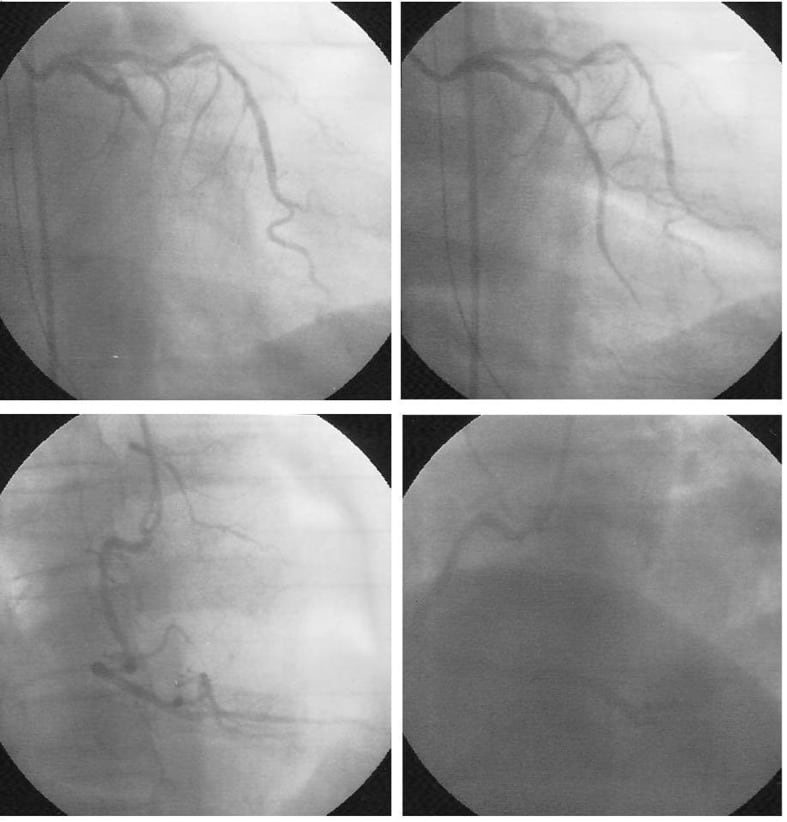IHD results from an imbalance between myocardial oxygen demand and supply. The most common cause of IHD is atherosclerotic disease of the coronary arteries or CAD (coronary artery disease). It most commonly involves the left anterior descending (LAD) branch of the left coronary artery, followed by right coronary artery (RCA) and left circumflex artery (LCx). Significant coronary stenosis occurs when there is more than 75% decrease in the vessel lumen. Risk factors are male gender (> 45 years of age), post-menopausal females, smoking, DM, insulin resistance, older age, family history of premature CAD, hypertension, hypercholesterolemia and dyslipidemia.
I) Angina pectoris: It is chest pain that results from transient myocardial ischemia not severe enough to cause cell death. Patients with typical or stable angina give a history of poorly localised pain or discomfort in the retrosternal area and/or arm that is exacerbated by exertion or emotional stress and relieved by rest and nitroglycerine. Tenderness to palpation is not a characteristic of anginal pain.
Angina is of the following three types:
II) Acute coronary syndrome or ACS: It refers to symptoms caused by acute myocardial ischemia and includes ST elevation MI (STEMI), non-ST elevation MI (NSTEMI) and unstable angina. It may present as sudden cardiac death. Prompt management of ACS is essential to save lives. Hemorrhage or ulceration of a plaque resulting in thrombosis and closing off of an already narrowed lumen from atherosclerosis is the most common mechanism of AMI or acute myocardial infarction. Affected myocardium is irreversibly necrosed in AMI. Non-atherosclerotic causes can rarely cause AMI, such as vasculitis, coronary arterial stenosis, severe coronary spasm ,aortic dissection, hypercoagulability etc.

(Upper panel) coronary angiography of left coronary artery shows total occlusion on the mid portion of left circumflex artery (left), and after stent deployed (right); (lower panel) coronary angiography of right coronary artery.
Patients typically present with retrosternal chest pain often described as crushing or pressure , radiation of pain to neck, jaw, left shoulder, left arm, diaphoresis, fatigue, epigastric pain, nausea, vomiting or syncope. The pain typically lasts for more than 30 minutes and is not relieved by rest or nitroglycerine. Variations of classic presentations are seen in diabetics and women. AMI may be full-thickness or transmural; it may be subendocardial, where only the inner third of the myocardium is infarcted (remember this area is perfused the last). Coronary thrombosis may or may not be present in subendocardial infarcts, main pathology being hypoperfusion, as in shock and aortic stenosis.
| Time since AMI | Gross changes | Microscopic changes |
| 0-6 hours | No change | Hypereosinophilic myocardium, wavy fibres, EM changes# |
| 6-12 hours | Infarcted area appears whitish or pale while non-infarcted area appears brick-red on TTC stain* | Coagulative necrosis starts; Early neutrophilic infiltrates; edema |
| 12-24 hours | Dark mottling | Progression of above changes; more prominent neutrophilic infiltrates |
| Days 1-3 | Pallor; mottled area with a yellow tan core | Loss of nuclei and striations on myocytes; abundant neutrophils |
| Days 3-7** | Yellow and soft centre; hyperemic border | Myocyte fragmentation; early phagocytosis; macrophages appear; early granulation tissue |
| Days 7-10 | Bright yellow necrotic area; red-purple periphery | Prominent granulation tissue; necrosis is complete (in smaller infarcts); loose collagen; pigmented macrophages*** containing hemosiderin and lipofuscin |
| Days 10-14 | Red-grey borders | Fibrocollagenous tissue at periphery |
| Weeks 2-8 | Thin, grey-white, fibrous scar | Denser collagen, scanty cells |
| Month 2-3 | Scarring complete | Mature collagen |
| Changes in reperfusion injury | Hemorrhagic, red infarct area | Contraction band necrosis |
*TTC or triphenyltetrazolium chloride is a histochemical stain that is used to differentiate between infarcted and non-infarcted tissue. It depends on the activity of dehydrogenases in metabolically active cells.
**As the infarcted area is soft, there is maximal risk of rupture of the heart from days 3-7
***Pigmented macrophages may persist for years
#EM or electron microscopy changes can be seen within a few minutes of the infarct. Swollen mitochondria, disruption of sarcolemma, clumping of nuclear chromatin and glycogen depletion occur within the first 30 minutes of infarction.
Sign up for free to take 6 quiz questions on this topic